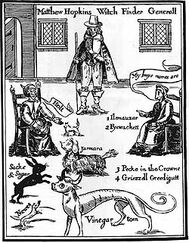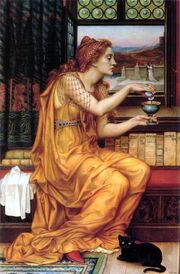
In European folklore and folk-belief of the Mediaeval and Early Modern periods, familiar spirits, sometimes referred to simply as familiars, were supernatural entities that were believed to assist witches and cunning folk in their practice of magic.
Definitions
Familiars have been described as the alter-ego, spirit companion, or animal that aids a witch.
The definition of a familiar may vary from person to person. Some believe that the familar is a projection of the self, others that it is a separate entity, and still others that it is a physical animal.
Relationship between Magical Practitioner and Familiar
Using her studies into the role of witchcraft and magic in Britain during the Early Modern period as a starting point, the historian Emma Wilby examined the relationship that familiar spirits allegedly had with the witches and cunning-folk in this period.
In the British accounts from the Early Modern period at least, there were three main types of encounter narrative related to how a witch or cunning person first met their familiar. The first of these was that the spirit spontaneously appeared in front of the individual whilst they were going about their daily activities, either in their home or outdoors somewhere. Various examples for this are attested in the sources of the time, for instance, Joan Prentice from Essex, England, gave an account when she was interrogated for witchcraft in 1589 claiming that she was "alone in her chamber, and sitting upon a low stool preparing herself to bedward" when her familiar first appeared to her, whilst the Cornish cunning-woman Anne Jeffries related in 1645 that hers first appeared to her when she was "knitting in an arbour in our garden".
The second manner in which the familiar spirit commonly appeared to magical practitioners in Britain was that they would be gifted to a person by a pre-existing individual, who was sometimes a family member and at other times a more powerful spirit. For instance, the alleged witch Margaret Ley from Liverpool claimed, in 1667, that she had been gifted her familiar spirit from her mother when she died, whilst the leicestershire cunning-woman Joan Willimot related, in 1618, that a mysterious figure whom she only referred to as her "master", "willed her to open her mouth and he would blow into her a fairy which should do her good. And that she open her mouth, and that presently after blowing, there came out of her mouth a spirit which stood upon the ground in the shape and form of a woman."
In a number of accounts, the cunning person or witch was experiencing difficulty prior to the appearance of the familiar, who offered to aid them. As historian Emma wilby noted, "their problems… were primarily rooted in the struggle for physical survival - the lack of food or money, bereavement, sickness, loss of livelihood and so on", and the familiar offered them a way out of this by giving them magical powers.
The Witch's Familiar
'The concept of the familiar has been a vital component of various cultures throughout man's history. The

A witch sits with her cat familiar
Romans, for example, believed that each household was protected by a familiar whose job it was to keep the family from harm, and shamans and medicine men of various tribal traditions have long honored the spirits of animals for their wisdom and assistance in magickal workings.
Yet despite these positive influences, when we think of a familiar the most common image is that of the evil witch with her fearsome-looking black cat. This archetype, straight from the fairytales of our childhood, has its roots in the fear and superstition of the Dark Ages, and it bears no resemblance to the modern-day familiar.
Today's witches view their familiars in an altogether different light. For the modern witch, a familiar can be any animal with which the individual feels an affinity. While these animals are not considered evil spirits, they're far from being just a household pet and are treated as partners in the practice of magick.
Because animals are believed to be more sensitive to vibrations from the unseen world, they are useful to the witch as a kind of psychic sensor, indicating the presence of negative energy by their behavior. Familiars also bring added energy to magickal workings because of their close affinity with the spirit world and their attunement with their witch.
The finding of an animal familiar is a very personal thing, and often the witch will send out a psychic call to attract a suitable one. An immediate and overwhelming feeling of kinship between the witch and the animal usually signifies the discovery of the new familiar.
In some cases familiars are not confined to physical bodies. Although they play the same role as animal familiars, spirit familiars are more versatile in that they can move about more freely. The presence of these sprit familiars is often experienced as a voice, vision, or strong feeling of peace. If necessary, they can be associated with inanimate objects, such as a stone or piece of jewelry, to make contacting the spirit an easy task. Non-Pagan history describes familiars as low-ranking demons in constant attention to Witches for the purpose of carrying out spells and bewitchments. Familiars usually assumed animal forms - cats, toads, owls, mice and dogs seem to have been the most common - though virtually any animal or insect could be suspected. In the Witchcraft Trials, if so much as a fly buzzed in the window while someone suspected of being a witch was being questioned or tried, it was said to be her (or his) familiar. The inquisitors took the Bible to heart: those who had familiars were "an abomination unto the Lord" and should be "Put to death: they shall stone them with stones: Their blood shall be upon them" (Lev. 20:27).
Familiars - also called imps - were said to be given to Witches by the Devil or bought or inherited from other Witches. A Witch could have several of them. Cats were the favored forms, especially black ones. The fear that all cats were Witches' familiars was one of the primary reasons for the famous cat massacres that swept through medieval Europe.
Familiars were given names like any household pet, which most of them undoubt- edly were. Perhaps the best known familiar name is Pyewackett, the moniker the Witch's cat in the movie Bell, Book and Candle, and a name that dates back to Renaissance England. Pyewackett, Matthew Hopkins (the famous Witch hunter) stated, was a name "no mortal could invent."
During the Witch hysteria of the Middle Ages and Renaissance, the obsession with familiars was confined mostly to England and Scotland, where they are mentioned in numerous trial records, especially those related to Hopkins. The Witchcraft Act of 1604 made it a felony to "consult, convene with, entertain, employ, feed, or reward any evil and wicked spirit to or for any intent or purpose." But the Malleus Maleficarum (1486), the major Witch inquisitor's handbook, offers no instructions concerning familiars in the interrogation and trial of Witches. The book does acknowledge that an animal familiar "always works with the Witch in everything."
There is a scant evidence of familiars in early American Witch trials. In the Salem Trials in 1692, John Bradsheet was indicted for "inciting a dog to afflict." The dog was tried and hanged as a Witch. Outside of Witch trials, more benevolent familiars were believed to exist, serving wizards and wise men (and women) who were magicians or village healers. The familiars helped diagnose illnesses and the sources of bewitchment and were used for divining and finding lost objects and treasures. Magicians conjured them in rituals, then locked then in bottles, rings and stones. They sometimes sold them as charms, claiming the spirits would ensure success in gambling, love, business or whatever the customer wanted. This sort of familiar was technically not illegal; England's Witchcraft Act of 1604 prohibited only evil and wicked spirits. Some familiars were said to be Faeries. Oberon was a popular name for fairy familiars in 15th and 16th century England.
Many modern Witches have animal familiars, usually cats, which are their magical helpers. Some also have dogs, birds, snakes or toads. Witches do not believe the familiars are "demons" or spirits in animal form but simply animals whose psychic attunement makes them ideal partners in magical workings. Some Witches say that it is possible to endow pets with magical powers and turn them into familiars, though others don't believe it should be done. Still others believe familiars are never "pets" (and should never be treated as such) but are animals who volunteer to work as familiars and are Karmically attracted to Witches. Witches who do not have familiars send out psychic "calls" to draw the right animal.
Familiars reputedly are sensitive to psychic vibrations and power and are welcomed partners inside the magic circle and other magical work. They also serve as psychic radar, reacting visibly to the presence of any negative or evil energy, whether it be an unseen force or a person who dabbles in the wrong kind of magic. Familiars are also given psychic protection by their Witches. Some Witches it seems also use the term familiar to describe thought-forms created magically and empowered to carry out a certain task on the astral plane.
Sorcerers and shamans in cultures around the world also have helpers in the form of spirits. Dispatching them on errands to heal, harm or kill - called sending. The physical shape of a familiar varies. New Guinea sorcerers rely on snakes and crocodiles, while in Malaya, the familiar is usually an owl or badger passed down from generation to generation. Throughout Africa, the wild creatures of the bush are said to be Witches' familiars: for the Lugbara, they are said to be the toad, snake, lizard, water frog, bat, owl, leopard, jackal and a type of monkey that screeches in the night; for the Dinka, they are black cobras and hyenas. The Zulus' familiars are said to be corpses dug up and re-animated with magic; they are sent out at on night errands to scare travelers with their shrieking and pranks. In Shamanism, a novice shaman acquires his familiar spirits, usually manifesting in animal, reptile or bird shapes, when he completes his initiation. He or she may send them out to do battle in his or her place, but if they die, so does the shaman. Familiars usually stay with their shaman until death, then disappear. Among certain Eskimos, the familiar is embodied in an artificial seal, not a live animal.
In closing, what I usually instruct in this area is that the student of magic who feels that they have found a familiar is that they should practice an exercise called "Trading Places" by Keith Harry. This exercise is simple enough to memorize and to practice, and though it was not written specifically for bonding with an animal familiar it was designed for becoming familiar with an animal, and inducing a mystical experience. I think you will readily discern its value in the acquiring of a familiar. ''' '